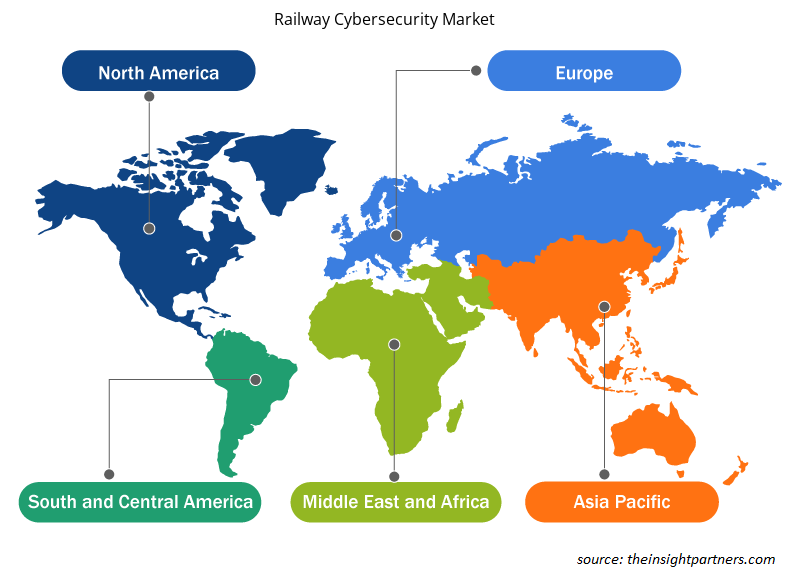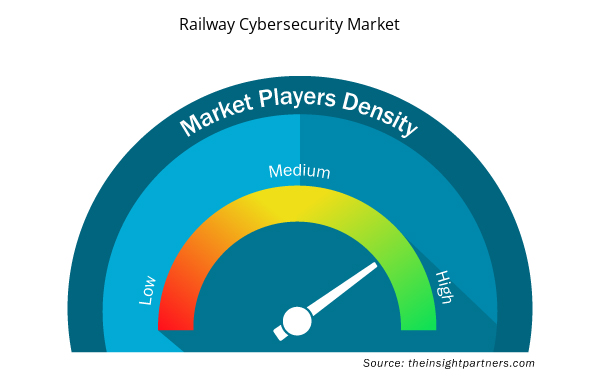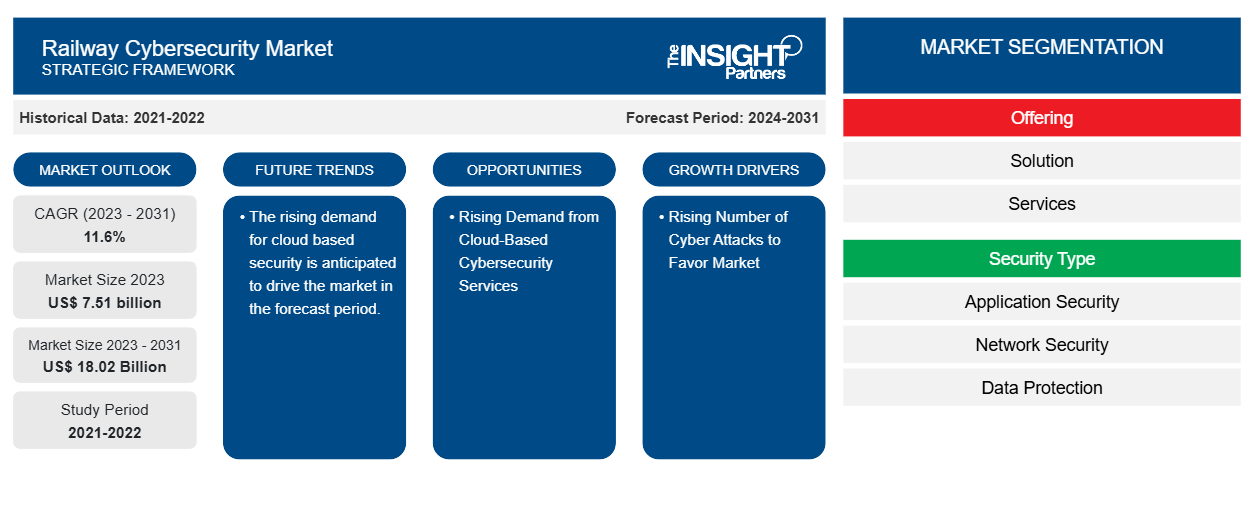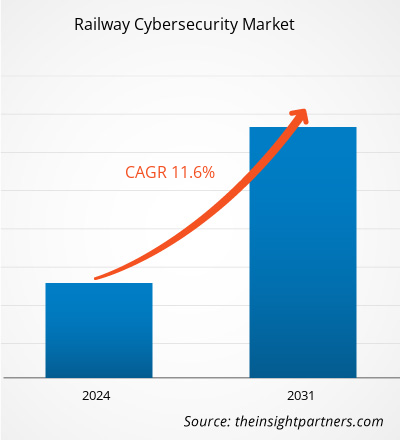Se prevé que el tamaño del mercado de ciberseguridad ferroviaria alcance los 18.020 millones de dólares en 2031, frente a los 7.510 millones de dólares en 2023. Se espera que el mercado registre una CAGR del 11,6 % durante el período 2023-2031. Es probable que el creciente número de ciberataques y la creciente adopción de soluciones de movilidad inteligente en los ferrocarriles sean los principales impulsores y tendencias del mercado.
Análisis del mercado de ciberseguridad ferroviaria
El mercado de la ciberseguridad ferroviaria está experimentando un crecimiento significativo a nivel mundial. Este crecimiento se atribuye al creciente número de ciberataques y a la creciente adopción de soluciones de movilidad inteligente en los ferrocarriles. Además, las crecientes leyes y regulaciones de ciberseguridad y la creciente demanda de servicios de ciberseguridad basados en la nube son los factores que se prevé que impulsen el crecimiento del mercado de la ciberseguridad ferroviaria en los próximos años.
Descripción general del mercado de ciberseguridad ferroviaria
La ciberseguridad en los ferrocarriles está adquiriendo una gran importancia debido a la creciente dependencia de los sistemas y tecnologías digitales. A medida que los ferrocarriles se han ido modernizando, han adoptado diversos sistemas informáticos para supervisar y controlar las operaciones, desde la señalización y la gestión de las vías hasta la gestión de pasajeros y la emisión de billetes. Esta digitalización ha hecho que los sistemas ferroviarios sean más cómodos y eficientes para los pasajeros y los operadores.
Personalice este informe según sus necesidades
Obtendrá personalización en cualquier informe, sin cargo, incluidas partes de este informe o análisis a nivel de país, paquete de datos de Excel, así como también grandes ofertas y descuentos para empresas emergentes y universidades.
- Obtenga las principales tendencias clave del mercado de este informe.Esta muestra GRATUITA incluirá análisis de datos, desde tendencias del mercado hasta estimaciones y pronósticos.
Factores impulsores y oportunidades del mercado de la ciberseguridad ferroviaria
El creciente número de ataques cibernéticos favorece al mercado
Las infraestructuras críticas del ferrocarril están cada vez más expuestas a posibles ciberataques. La conectividad y el uso de la tecnología en todos los sectores han mejorado el servicio prestado a los ciudadanos, optimizando procesos y recursos y mejorando la calidad de las acciones de cada operador. Pero esta conectividad también tiene su lado oscuro, facilitando la actuación de actores maliciosos que puedan atacar e interrumpir el servicio correspondiente. El sector se enfrenta a varias ciberamenazas que pueden afectar significativamente a su operativa. Los principales componentes a los que podrían dirigirse los ciberataques incluyen los sistemas de control y señalización, las redes de comunicación y los sistemas de gestión del tráfico, los sistemas de información al pasajero y de emisión de billetes, así como las infraestructuras de mantenimiento y gestión de activos.
Creciente demanda de servicios de ciberseguridad basados en la nube.Cybersecurity Services.
Se prevé que la creciente demanda de servicios de ciberseguridad basados en la nube impulsará el mercado en los próximos años. Las soluciones de ciberseguridad basadas en la nube pueden ayudar en la gestión y el monitoreo automáticos de los sistemas de señalización ferroviaria. Se puede rastrear el estado de cada señal mediante sensores y cambiar y modificar automáticamente los ajustes según sea necesario. Puede ayudar a mejorar la productividad y prevenir problemas antes de que ocurran. Un sensor , por ejemplo, detectará un problema con una señal en particular al instante. Y en la nube, se realizarán cambios en tiempo real que afectarán solo a esa señal. De esta manera, los trenes pueden evitar esas señales sin demoras ni interrupciones.cybersecurity services is anticipated to drive the market in the coming years. Cloud-based cybersecurity solutions can aid in the automatic management and monitoring of railway signalling systems. One can track the status of each signal using sensors and automatically change and modify settings as needed. It can assist in enhancing productivity and prevent problems before they occur. A
Análisis de segmentación del informe de mercado de ciberseguridad ferroviariaCybersecurity Market Report Segmentation Analysis
Los segmentos clave que contribuyeron a la derivación del análisis del mercado de ciberseguridad ferroviaria son la oferta, el tipo de seguridad, el tipo y la aplicación.cybersecurity market analysis are offering, security type, type, and application.
- En función de la oferta, el mercado de ciberseguridad ferroviaria se divide en soluciones (gestión de riesgos y cumplimiento, cifrado, cortafuegos, antivirus/antimalware, detección/prevención de intrusiones y otros) y servicios. Se prevé que el segmento de soluciones ocupe una cuota de mercado significativa en el período de previsión.cybersecurity market is divided into solutions (risk and compliance management, encryption, firewall, antivirus/antimalware, intrusion detection/intrusion prevention, and others) and services. The solution segment is anticipated to hold a significant market share in the forecast period.
- Según el tipo de seguridad, el mercado de ciberseguridad ferroviaria se divide en seguridad de aplicaciones, seguridad de redes, protección de datos, seguridad de puntos finales y administración de sistemas. Se prevé que el segmento de seguridad de aplicaciones ocupe una cuota de mercado significativa en el período de pronóstico.cybersecurity market is divided into application security, network security, data protection, endpoint security, and system administration. The application security segment is anticipated to hold a significant market share in the forecast period.
- Por tipo, el mercado se segmenta en tecnología operativa (OT) y tecnología de la información (TI). Se prevé que el segmento de tecnología operativa (OT) tenga una participación de mercado significativa en el período de pronóstico.
Análisis de la cuota de mercado de la ciberseguridad ferroviaria por geografíaCybersecurity Market Share Analysis by Geography
El alcance geográfico del informe del mercado de ciberseguridad ferroviaria se divide principalmente en cinco regiones: América del Norte, Asia Pacífico, Europa, Medio Oriente y África, y América del Sur y Central.cybersecurity market report is mainly divided into five regions: North America, Asia Pacific, Europe, Middle East & Africa, and South & Central America.
América del Norte ha dominado el mercado de la ciberseguridad ferroviaria. Las tendencias de adopción de alta tecnología en diversas industrias de la región de América del Norte han impulsado el crecimiento del mercado de la ciberseguridad ferroviaria. Se espera que factores como la mayor adopción de herramientas digitales y el alto gasto tecnológico por parte de las agencias gubernamentales impulsen el crecimiento del mercado de la ciberseguridad ferroviaria de América del Norte. Además, un fuerte énfasis en la investigación y el desarrollo en las economías desarrolladas de los EE. UU. y Canadá está obligando a los actores norteamericanos a traer soluciones tecnológicamente avanzadas al mercado. Además, Estados Unidos tiene un gran número de actores del mercado de la ciberseguridad ferroviaria que se han centrado cada vez más en el desarrollo de soluciones innovadoras. Todos estos factores contribuyen al crecimiento del mercado de la ciberseguridad ferroviaria en la región.cybersecurity market. High technology adoption trends in various industries in the North American region have fuelled the growth of the railway cybersecurity market. Factors such as increased adoption of digital tools and high technological spending by government agencies are expected to drive the North American railway cybersecurity market growth. Moreover, a strong emphasis on research and development in the developed economies of the US and Canada is forcing the North American players to bring technologically advanced solutions into the market. In addition, the US has a large number of railway cybersecurity market players who have been increasingly focusing on developing innovative solutions. All these factors contribute to the region's growth of the railway cybersecurity market.
Perspectivas regionales del mercado de ciberseguridad ferroviariaCybersecurity Market Regional Insights
Los analistas de Insight Partners explicaron en detalle las tendencias y los factores regionales que influyen en el mercado de ciberseguridad ferroviaria durante el período de pronóstico. Esta sección también analiza los segmentos y la geografía del mercado de ciberseguridad ferroviaria en América del Norte, Europa, Asia Pacífico, Oriente Medio y África, y América del Sur y Central.Cybersecurity Market throughout the forecast period have been thoroughly explained by the analysts at Insight Partners. This section also discusses Railway Cybersecurity Market segments and geography across North America, Europe, Asia Pacific, Middle East and Africa, and South and Central America.

- Obtenga datos regionales específicos para el mercado de ciberseguridad ferroviaria
Alcance del informe sobre el mercado de ciberseguridad ferroviaria
| Atributo del informe | Detalles |
|---|---|
| Tamaño del mercado en 2023 | 7.510 millones de dólares estadounidenses |
| Tamaño del mercado en 2031 | US$ 18.02 mil millones |
| CAGR global (2023 - 2031) | 11,6% |
| Datos históricos | 2021-2022 |
| Período de pronóstico | 2024-2031 |
| Segmentos cubiertos | Al ofrecer
|
| Regiones y países cubiertos | América del norte
|
| Líderes del mercado y perfiles de empresas clave |
|
Densidad de actores del mercado de ciberseguridad ferroviaria: comprensión de su impacto en la dinámica empresarial
El mercado de la ciberseguridad ferroviaria está creciendo rápidamente, impulsado por la creciente demanda de los usuarios finales debido a factores como la evolución de las preferencias de los consumidores, los avances tecnológicos y una mayor conciencia de los beneficios del producto. A medida que aumenta la demanda, las empresas amplían sus ofertas, innovan para satisfacer las necesidades de los consumidores y aprovechan las tendencias emergentes, lo que impulsa aún más el crecimiento del mercado.
La densidad de actores del mercado se refiere a la distribución de las empresas o firmas que operan dentro de un mercado o industria en particular. Indica cuántos competidores (actores del mercado) están presentes en un espacio de mercado determinado en relación con su tamaño o valor total de mercado.
Las principales empresas que operan en el mercado de la ciberseguridad ferroviaria son:
- CAPGEMINI SE
- Sistemas Cisco, Inc.
- Aeroespacial Collins
- Marca: Hitachi
- Compañía de tecnologías Huawei
- Limitado.
Descargo de responsabilidad : Las empresas enumeradas anteriormente no están clasificadas en ningún orden particular.

- Obtenga una descripción general de los principales actores clave del mercado de ciberseguridad ferroviaria
Noticias y desarrollos recientes del mercado de ciberseguridad ferroviaria
El mercado de la ciberseguridad ferroviaria se evalúa mediante la recopilación de datos cualitativos y cuantitativos a partir de una investigación primaria y secundaria, que incluye importantes publicaciones corporativas, datos de asociaciones y bases de datos. A continuación, se enumeran algunos de los avances en el mercado de la ciberseguridad ferroviaria:
- Cylus, líder reconocido en soluciones de ciberseguridad ferroviaria, anunció un logro: su solución insignia CylusOne ha obtenido el codiciado título de ser la primera solución de ciberseguridad ferroviaria del mundo en obtener la prestigiosa certificación IEC 62443-4-2 en el nivel de seguridad 3. (Fuente: sitio web de la empresa Cylus, febrero de 2024)
- Strides International Business firmará un memorando de entendimiento (MoU) con Egis para la prestación de servicios de ciberseguridad en el sector ferroviario. (Fuente: sitio web de la empresa Strides International Business, noviembre de 2023)
Cobertura y resultados del informe sobre el mercado de ciberseguridad ferroviaria
El informe “Tamaño y pronóstico del mercado de ciberseguridad ferroviaria (2021-2031)” proporciona un análisis detallado del mercado que cubre las siguientes áreas:
- Tamaño del mercado de ciberseguridad ferroviaria y pronóstico a nivel mundial, regional y nacional para todos los segmentos clave del mercado cubiertos bajo el alcance
- Tendencias del mercado de ciberseguridad ferroviaria, así como dinámicas del mercado, como impulsores, restricciones y oportunidades clave
- Análisis detallado de las cinco fuerzas de Porter y PEST y FODA
- Análisis del mercado de ciberseguridad ferroviaria que abarca las tendencias clave del mercado, el marco global y regional, los principales actores, las regulaciones y los desarrollos recientes del mercado
- Análisis del panorama de la industria y de la competencia que abarca la concentración del mercado, el análisis de mapas de calor, los actores destacados y los desarrollos recientes del mercado de ciberseguridad ferroviaria
- Perfiles detallados de empresas
- Análisis histórico (2 años), año base, pronóstico (7 años) con CAGR
- Análisis PEST y FODA
- Tamaño del mercado Valor/volumen: global, regional, nacional
- Industria y panorama competitivo
- Conjunto de datos de Excel



Report Coverage
Revenue forecast, Company Analysis, Industry landscape, Growth factors, and Trends

Segment Covered
This text is related
to segments covered.

Regional Scope
North America, Europe, Asia Pacific, Middle East & Africa, South & Central America

Country Scope
This text is related
to country scope.
Preguntas frecuentes
The global railway cybersecurity market is expected to reach US$ 18.02 billion by 2031.
The expected CAGR of the railway cybersecurity market is 11.6%.
The key players holding majority shares in the global railway cybersecurity market are CAPGEMINI SE, Cisco Systems, Inc., Collins Aerospace, Hitachi, Ltd., Huawei Technologies Co., Ltd., IBM Corporation, Nokia Corporation, Selectron Systems AG, Siemens AG, and Thales Group.
The rising demand for cloud based security is anticipated to drive the market in the forecast period.
North America is anticipated to dominate the railway cybersecurity market in 2023.
The rising number of cyberattacks and the growing adoption of smart mobility solutions in railways are some of the factors driving the railway cybersecurity market.
Trends and growth analysis reports related to Technology, Media and Telecommunications : READ MORE..
The Insight Partners performs research in 4 major stages: Data Collection & Secondary Research, Primary Research, Data Analysis and Data Triangulation & Final Review.
- Data Collection and Secondary Research:
As a market research and consulting firm operating from a decade, we have published and advised several client across the globe. First step for any study will start with an assessment of currently available data and insights from existing reports. Further, historical and current market information is collected from Investor Presentations, Annual Reports, SEC Filings, etc., and other information related to company’s performance and market positioning are gathered from Paid Databases (Factiva, Hoovers, and Reuters) and various other publications available in public domain.
Several associations trade associates, technical forums, institutes, societies and organization are accessed to gain technical as well as market related insights through their publications such as research papers, blogs and press releases related to the studies are referred to get cues about the market. Further, white papers, journals, magazines, and other news articles published in last 3 years are scrutinized and analyzed to understand the current market trends.
- Primary Research:
The primarily interview analysis comprise of data obtained from industry participants interview and answers to survey questions gathered by in-house primary team.
For primary research, interviews are conducted with industry experts/CEOs/Marketing Managers/VPs/Subject Matter Experts from both demand and supply side to get a 360-degree view of the market. The primary team conducts several interviews based on the complexity of the markets to understand the various market trends and dynamics which makes research more credible and precise.
A typical research interview fulfils the following functions:
- Provides first-hand information on the market size, market trends, growth trends, competitive landscape, and outlook
- Validates and strengthens in-house secondary research findings
- Develops the analysis team’s expertise and market understanding
Primary research involves email interactions and telephone interviews for each market, category, segment, and sub-segment across geographies. The participants who typically take part in such a process include, but are not limited to:
- Industry participants: VPs, business development managers, market intelligence managers and national sales managers
- Outside experts: Valuation experts, research analysts and key opinion leaders specializing in the electronics and semiconductor industry.
Below is the breakup of our primary respondents by company, designation, and region:

Once we receive the confirmation from primary research sources or primary respondents, we finalize the base year market estimation and forecast the data as per the macroeconomic and microeconomic factors assessed during data collection.
- Data Analysis:
Once data is validated through both secondary as well as primary respondents, we finalize the market estimations by hypothesis formulation and factor analysis at regional and country level.
- Macro-Economic Factor Analysis:
We analyse macroeconomic indicators such the gross domestic product (GDP), increase in the demand for goods and services across industries, technological advancement, regional economic growth, governmental policies, the influence of COVID-19, PEST analysis, and other aspects. This analysis aids in setting benchmarks for various nations/regions and approximating market splits. Additionally, the general trend of the aforementioned components aid in determining the market's development possibilities.
- Country Level Data:
Various factors that are especially aligned to the country are taken into account to determine the market size for a certain area and country, including the presence of vendors, such as headquarters and offices, the country's GDP, demand patterns, and industry growth. To comprehend the market dynamics for the nation, a number of growth variables, inhibitors, application areas, and current market trends are researched. The aforementioned elements aid in determining the country's overall market's growth potential.
- Company Profile:
The “Table of Contents” is formulated by listing and analyzing more than 25 - 30 companies operating in the market ecosystem across geographies. However, we profile only 10 companies as a standard practice in our syndicate reports. These 10 companies comprise leading, emerging, and regional players. Nonetheless, our analysis is not restricted to the 10 listed companies, we also analyze other companies present in the market to develop a holistic view and understand the prevailing trends. The “Company Profiles” section in the report covers key facts, business description, products & services, financial information, SWOT analysis, and key developments. The financial information presented is extracted from the annual reports and official documents of the publicly listed companies. Upon collecting the information for the sections of respective companies, we verify them via various primary sources and then compile the data in respective company profiles. The company level information helps us in deriving the base number as well as in forecasting the market size.
- Developing Base Number:
Aggregation of sales statistics (2020-2022) and macro-economic factor, and other secondary and primary research insights are utilized to arrive at base number and related market shares for 2022. The data gaps are identified in this step and relevant market data is analyzed, collected from paid primary interviews or databases. On finalizing the base year market size, forecasts are developed on the basis of macro-economic, industry and market growth factors and company level analysis.
- Data Triangulation and Final Review:
The market findings and base year market size calculations are validated from supply as well as demand side. Demand side validations are based on macro-economic factor analysis and benchmarks for respective regions and countries. In case of supply side validations, revenues of major companies are estimated (in case not available) based on industry benchmark, approximate number of employees, product portfolio, and primary interviews revenues are gathered. Further revenue from target product/service segment is assessed to avoid overshooting of market statistics. In case of heavy deviations between supply and demand side values, all thes steps are repeated to achieve synchronization.
We follow an iterative model, wherein we share our research findings with Subject Matter Experts (SME’s) and Key Opinion Leaders (KOLs) until consensus view of the market is not formulated – this model negates any drastic deviation in the opinions of experts. Only validated and universally acceptable research findings are quoted in our reports.
We have important check points that we use to validate our research findings – which we call – data triangulation, where we validate the information, we generate from secondary sources with primary interviews and then we re-validate with our internal data bases and Subject matter experts. This comprehensive model enables us to deliver high quality, reliable data in shortest possible time.


 Obtenga una muestra gratuita de este informe
Obtenga una muestra gratuita de este informe